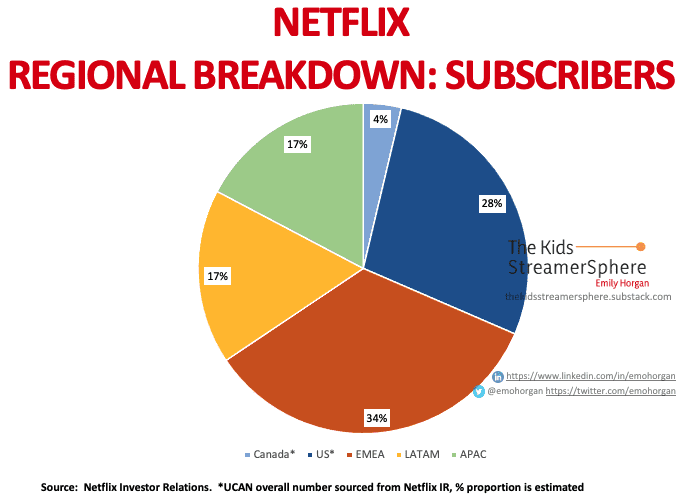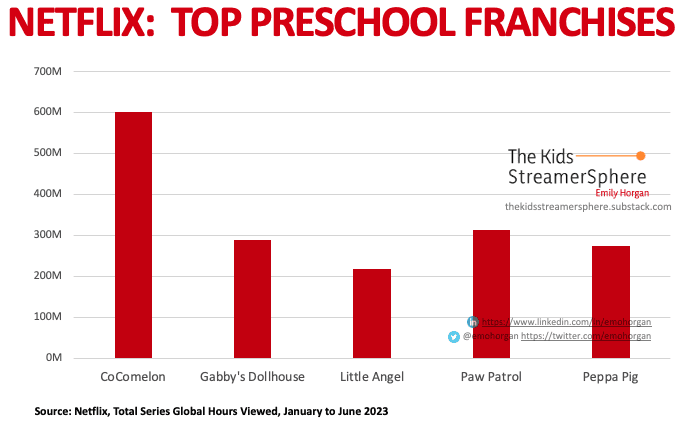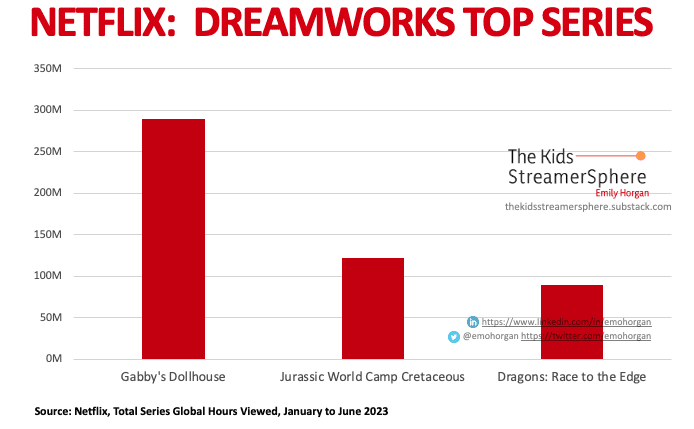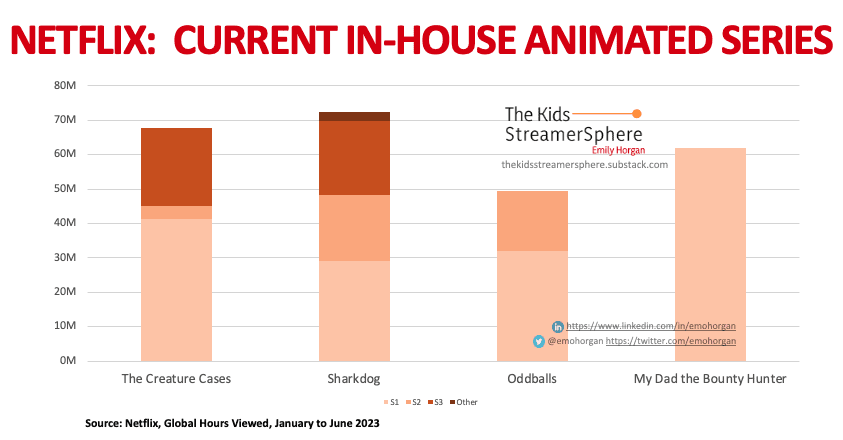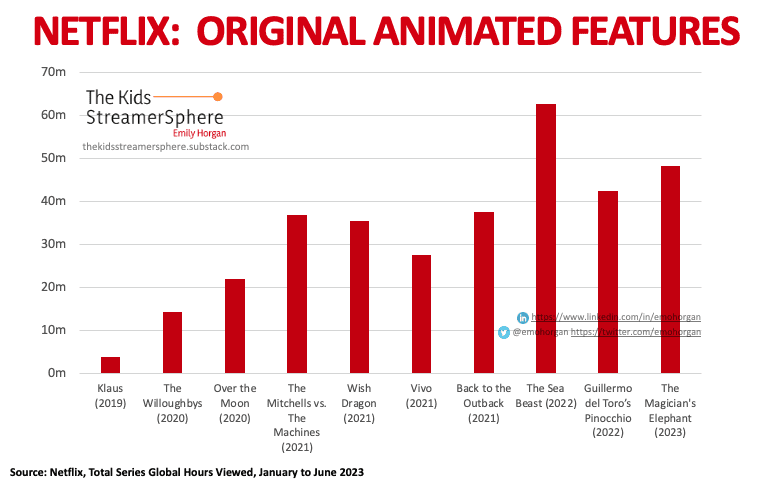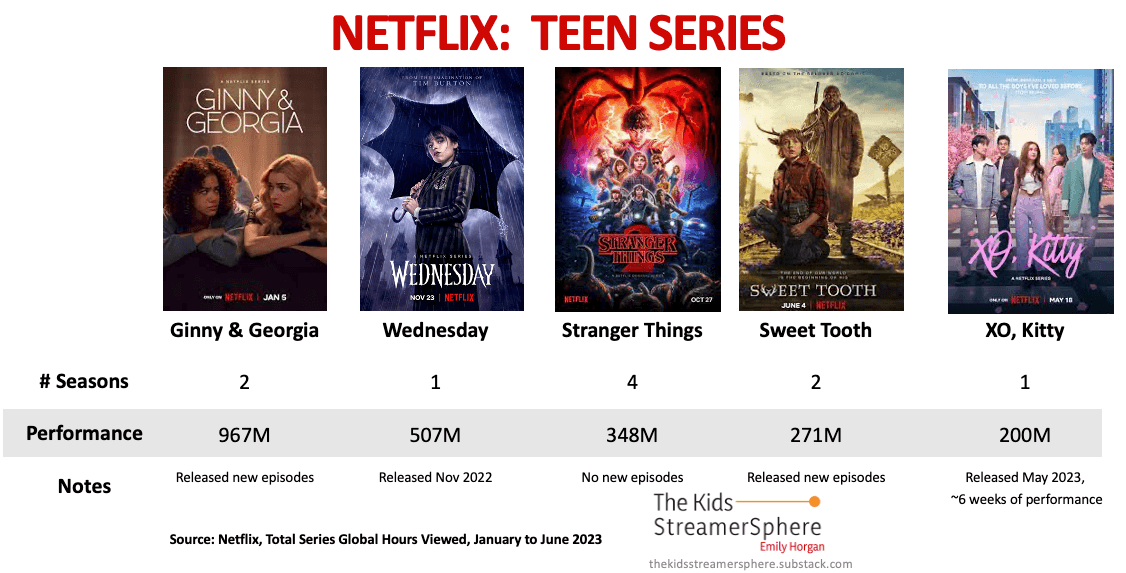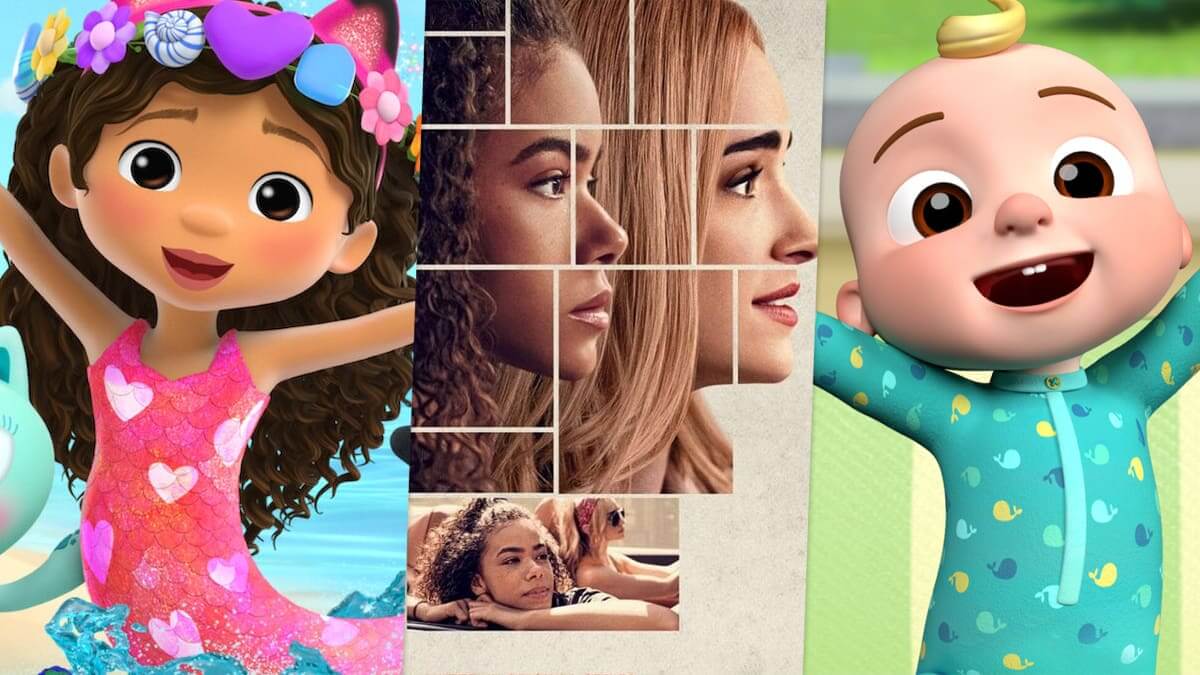
Pictures: DreamWorks Television / Netflix / MoonBug Entertainment
Out of nowhere, Netflix dropped the most insane data dump of content performance across more than 18,000 titles, covering the first half of 2023. Thanks, Netflix. Some of us have stuff to do… like partake in Christmas merriment… and, maybe, sleep…
In typical Netflix style, the dataset is a tough wrangle. A drowning of values, with numerous helpful indicators excluded. Much to the chagrin of number crunchers, concerted analysis requires extensive manual overlay of additional context. From a kid’s point of view, this would be helped by someone who had been looking in detail at the Netflix kid’s slate, ideally over the last few years, an Excel enthusiast who delights in maintaining lists with details others might find superfluous. Wait…
The below takeaways form the tip of the iceberg of kids’ insights, which can be gleaned from this dataset. The most exciting thing about this for me is the promise of consistency. We can expect this download of data every six months, allowing the picture great scale to grow.
Various journalists and analysts have unpacked the whys and wherefores of Netflix’s latest flex. Puck’s Matt Belloni brews some of the best tea, so here’s a gifted link to his take. Radical transparency, I guess, but a wise colleague asked the question… who is this data dump for? Wall Street? Striking unions? Producers? Competitors? The answer is all of the above, but I’ve said before that Netflix is using its dominance to call the yardstick by which the rest of the industry will be judged.
In terms of metrics, Netflix has been giving us two so far: hours viewed and “views.” The inverted commas are there because “views” is a simple mathing of hours viewed divided by duration, so it does not account for true unique reach. This can be problematic, particularly when considering repeat rates of kids viewing.
All data in this download is helpfully captured in the former hours viewed, but this will be skewed by content that has higher volumes and durations. Alas, no metric is perfect. I will say that this duration overlay isn’t majorly baked into the below takeaways. It would form the next stage of analysis, as it isn’t the kind of thing a moonlighting writer can cobble together in a couple of days.
So, without further ado, please see below nine quick kids’ media takeaways from the recent Netflix data dump. This is only the start, folks:
The spread of performance is VERY top heavy
Many publications are covering this point. Friend of the newsletter Brandon Katz of Parrot Analyticspointed out that the top 1,000 titles out of 18,000 (around 5%) drive nearly 60% of the viewing. Concentration at the top of the top is intense again: at #1 you have The Night Agent with 812 billion hours viewed. At the bottom, kids is represented with Miraculous: Tales of Ladybug & Cat NoirSeason 3: Part 2 rounding it out at #1,000 with 21.4 million.
We have a data point to demonstrate the importance of kids content in the wider industry
Of that top 1,000, kids titles account for approximately 13% of all hours viewed. This includes movies, with biggies from Illumination like Minions: The Rise of Gru, Sing and Sing 2, and the series covered in more detail below.
Global vs. Non-Global considerations and territory footprint (particularly US) is key
Global titles basically refers to anything that’s a pure Netflix Original. Anything non-global will be licensed, or Netflix will have been part of a fragmented commission structure/co-production. When looking at non-global titles, territory footprint is a key consideration, mainly whether or not the US is in the picture. It doesn’t count for EVERYTHING, but it is undoubtedly the one single market driving the most engagement, which impacts globally (around 28% per below).
4. CoComelon is still king
CoComelon reigns supreme as an absolute beast in terms of viewership. The IP has been slaying on all metrics across streaming since it got there. Nothing new, I know, but every so often we’re hit with a fresh, breathtaking way of seeing it. And let’s not forget quite how big it is on YouTube, one of a handful of kids IPs driving over 1 billion views monthly. For Netflix, this is not a fully global title, though all seasons are, crucially, present in the US, where we know from Nielsen that it is a major force of viewership. It’s worth noting that CoComelon dropped Season 7 and Season 8 during this time frame, so would definitely have benefited from “New” content platform real estate.
Staying with the same IP owner, Little Angel, CoComelon’s stablemate at Moonbug Entertainment, has also pulled astonishing viewership, though this does have the benefit of that global footprint. This show had a new series launch in July of this year, so it’s not part of this dataset. It will be interesting at the next drop to see how well it does.
5. If you can make it without the US, you’re a big deal
I’m looking at you up there, PAW Patrol.
Apparently, there are no PAW Patrol series currently on Netflix US, yet it’s STILL pulling in enough viewership to be holding its own against major franchises. Throw an extra 77 million hours viewed on to the above figures for the first movie (which is in the US), and there’s no questioning that the pups are a major part of preschoolers’ lives globally.
6. DreamWorks TV titles show that this remains a very valuable deal
DreamWorks TV Animation has had a standing output deal with Netflix dating back to 2013. You can imagine there might have been a wobble when DreamWorks’ parent company, Universal, launched their own streaming service, Peacock, but this for now any rockiness looks to have passed and the collaboration seems solid (although DreamWorks has diversified their streaming partners more than ever—smart move in this day and age!).
No surprise that Gabby’s Dollhouse tops the DreamWorks chart (see below), though perhaps few would have foreseen how many country miles she would have gone beyond her nearest competitor, Jurassic World: Camp Cretaceous. Both are current, buzzy franchise series, though Gabby will have had a promotion edge as new episodes dropped during the period.
What is very interesting is that Dragons: Race to the Edge comes in third. This is the crown jewel that Netflix acquired at the very start of the DreamWorks deal. Derived from the hugely successful How to Train Your Dragon film series, the first two seasons were on Cartoon Network before being gazumped to Netflix in 2015. The show is excellent and very beloved, but it’s still fascinating to see it holding its own so staunchly the guts of a decade later.
7. New content renews audiences
Current in-house animated series are seeing some good numbers. The Creature Cases, Sharkdog and Oddballs all featured in the top 1,000, having released Season 3, Season 3 and Season 2 respectively.
For all series, viewership for Season 1 came in higher than for the most recent one. This underlines how fresh content inevitably drives more platform real estate, with renewed opportunity for audiences, both new and old, to dive into a show. I know this is obvious, but it’s always nice to see it validated in data. The picture on how much elevation benefits a series in the long run will become clearer as we get new six-month drops.
8. Is there a decay model for Netflix animated features?
On Netflix Original animated features, there is an apparent (and unsurprising) softening as titles get older (though be kind to Klaus; this is a Christmas movie, and data would have missed this key thematic window). The Magician’s Elephant was a new film which launched halfway through the period of this data dump in March. Despite being nearly a year older, The Sea Beast is doing better business than this title. No wonder it has a sequel in the works.
9. Netflix really know how to serve teens
Last but by no means least, we have an outstanding showing of teen-appealing content. The pervasive narrative is that teens have left traditional media platforms, and probably hence traditional media formats, in favor of gaming and social. Don’t get me wrong, both feature prominently in the media diet of young people worldwide, but they’re still watching telly, folks, and they’re definitely watching Netflix. Big hitters with undeniable teen appeal have major profile across the top of the ranking. Ginny and Georgia, Wednesday, Sweet Tooth, and of course Stranger Things feature in the top 100. Brand new series XO, Kitty also had a monstrous launch when considered as an individual season. Netflix have been investing in this strategy for years, they know what they’re doing, they’ve established an audience, and they continue to reap the rewards.
So there you have it folks, nine quick kids takeaways from the recent Netflix data dump. And as we expect this to be a bi-annual affair, there are plenty of more insights to come. It will be interesting to see the picture build across series launches, discoverability, licensed vs. library titles, and animated features.
Note: This article first appeared on LinkedIn via The Kids StreamerSphere.

